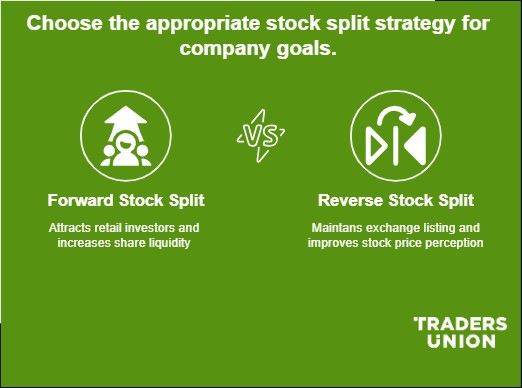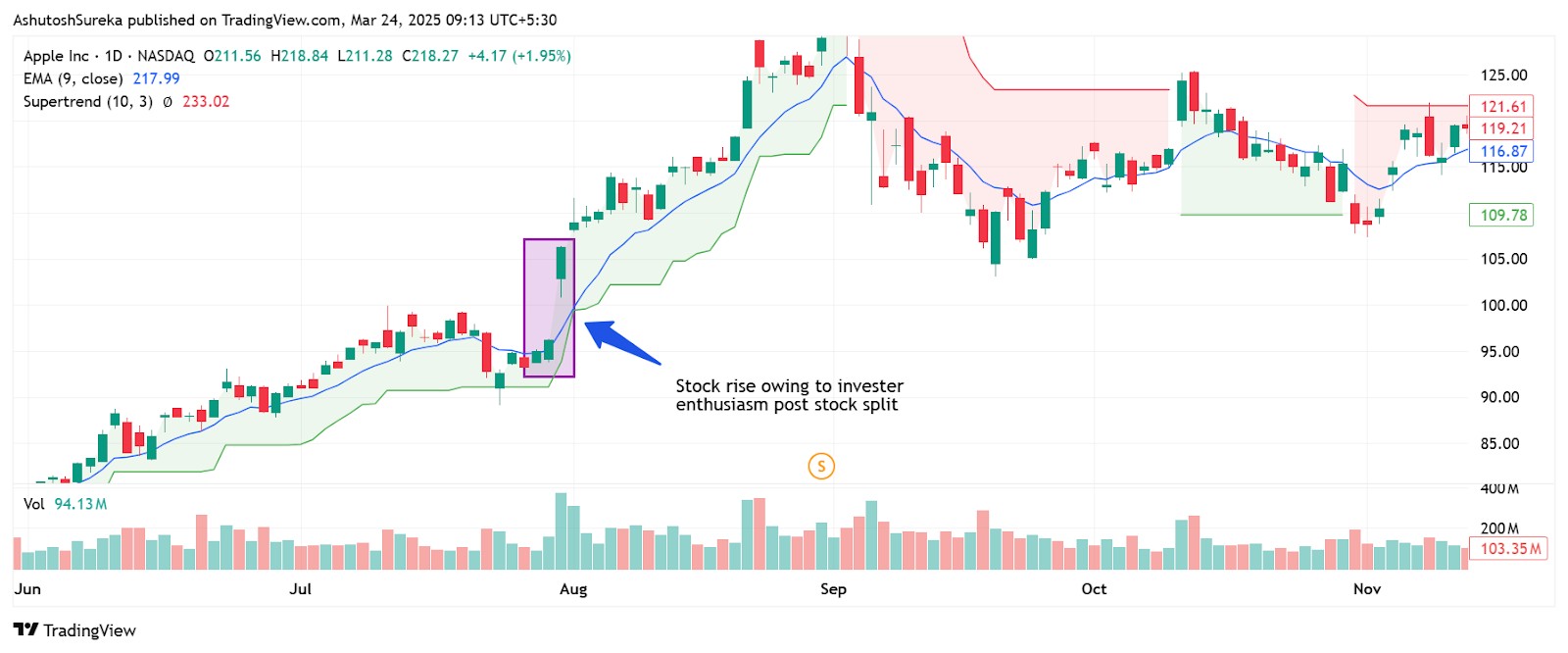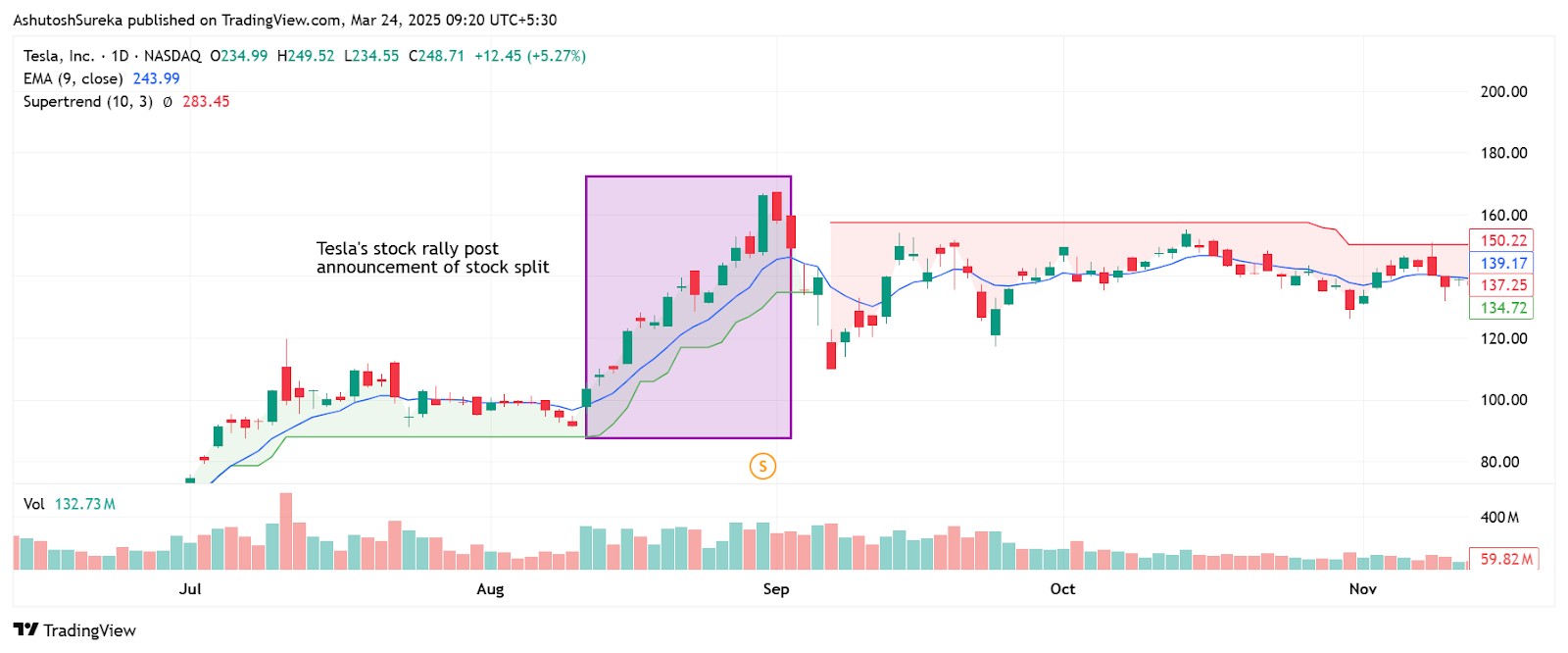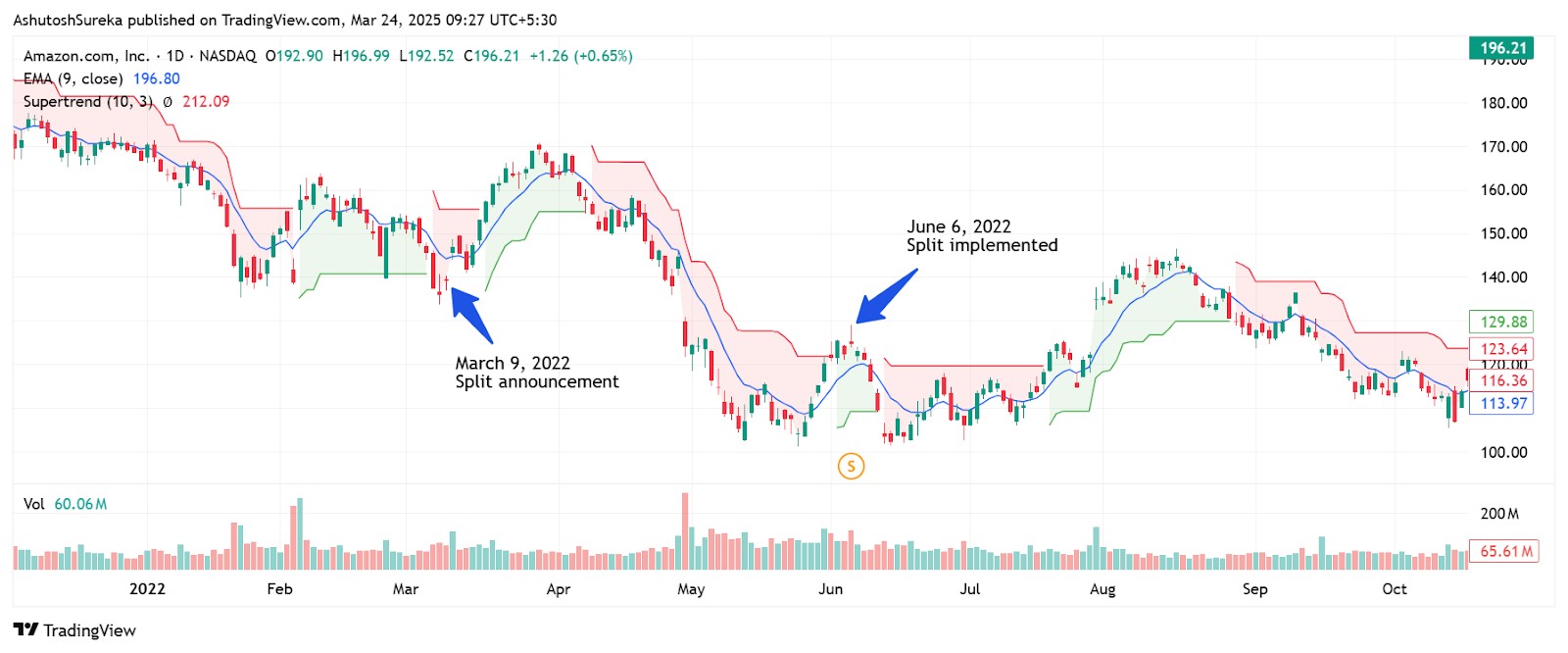How Stock Splits Impact Investor Psychology And Value Stocks



Editorial Note: While we adhere to strict Editorial Integrity, this post may contain references to products from our partners. Here's an explanation for How We Make Money. None of the data and information on this webpage constitutes investment advice according to our Disclaimer.
A stock split doesn’t change a company’s actual value, but it can boost investor interest by making shares appear more affordable. This psychological shift often increases trading volume and attracts retail investors, especially in tight markets where lower prices feel more accessible. While splits don’t guarantee gains, they can refresh a stock’s image and signal company confidence — key factors that may influence market behavior.
A stock split, on paper, doesn’t change a company’s value. But markets don’t run on math alone — they run on perception. When a stock that once traded at $1,200 is suddenly priced at $120, it simply feels more affordable, even if nothing’s changed underneath. That change in how people see the stock can influence buying decisions — especially when money is tight. In tough markets, it’s not just strong fundamentals that draw attention. Looking cheap can be just as powerful.
A split can shift the spotlight, making a solid but ignored company look like a brand-new opportunity. In this article, we’ll break down why stock splits matter more than they seem — and how they can shape investor behavior.
Risk warning: All investments carry risk, including potential capital loss. Economic fluctuations and market changes affect returns, and 40-50% of investors underperform benchmarks. Diversification helps but does not eliminate risks. Invest wisely and consult professional financial advisors.
Understanding stock splits
Stock splits don’t change the value of your investment — but they do change how it looks. Whether it’s more shares at a lower price or fewer shares at a higher one, stock splits can affect how a stock is perceived and traded. They’re a tool companies use to adjust share prices without changing their overall worth.

Definition and mechanics
A stock split is when a company divides its existing shares into more shares, while keeping the total value of those shares the same.
If a stock trades at $200 and splits 2-for-1, you’d now own twice as many shares at $100 each.
Your overall investment value doesn’t change — it’s just split across more shares.
Companies often do this to make their stock feel more affordable, especially for retail investors.
Stock splits don’t make a company stronger on paper, but they can increase interest from smaller investors and boost trading activity.
Types of stock splits

Forward stock splits
This is the type most people are familiar with. The company gives shareholders more shares while lowering the price per share, so the overall value stays the same.
It’s a move companies often make when their stock price has climbed a lot.
The idea is to make the stock more attractive and easier to buy in smaller amounts.
Apple and Tesla have both done this to invite more retail investors in.
Reverse stock splits
This works the opposite way. The company combines existing shares into fewer, higher-priced ones.
This is usually done when a stock’s price has dropped too low.
It can help companies stay listed on major exchanges or clean up their image with a higher price point.
But it’s often seen as a red flag, especially if the company is struggling financially.
Reasons companies initiate stock splits
Stock splits don’t change what a company is worth — but they can still serve a purpose. Whether it’s about getting more people to buy the stock or making it easier to trade, splits are often used as a way to keep shares within reach and appealing to a wider group of investors.
Enhancing liquidity
When a stock price climbs too high, it can start to feel out of reach for everyday investors. That’s when a company might step in and split the stock to bring the price down.
A lower price per share means more people can afford to invest.
As more people buy and sell, the stock becomes easier to trade without big price jumps.
It’s a simple way to keep the stock active and accessible, especially as the company grows.
This move helps attract more interest and gives both small and large investors a smoother trading experience.
Psychological appeal
Even if the math doesn’t change, a lower price feels better to many investors. A $100 stock just seems more inviting than a $1,000 one — even if both are worth the same in total.
It’s about perception — the stock feels more attainable.
Some investors even feel like they’re getting a better deal, or that the stock has more room to run.
And let’s face it, owning more shares just feels good, even if the value stays the same.
This mindset can create a wave of new interest, especially among retail investors who are just getting started or looking for the next opportunity.
Psychological impact on investors
Even though a stock split doesn’t change the actual value of what you own, it can still influence how people think about the stock. That’s because psychology plays a big role in the way we invest. A lower price can feel like a better deal, and a stock split often comes across as a vote of confidence from the company.
Perception of value
When a stock splits and the price per share drops, it may not change the math — but it changes how it feels. A share that was $400 and is now $100 after a split just seems easier to buy.
It makes the stock look like it has more room to grow, even if that’s just an illusion.
New investors are more likely to jump in when the price feels more within reach.
Many people like seeing a bigger number of shares in their portfolio, even if the total value is the same.
That feeling of “getting more for your money” can lead to higher interest and increased trading activity, especially among retail investors.
Signal of company confidence
When a company announces a stock split, it’s often seen as a sign that leadership is confident about the company’s future. Splits usually happen when a stock has done well — and they often suggest the company believes that momentum will continue.
Investors may take this as a hint that management expects strong performance ahead.
It also tells the market that the company wants to make shares more accessible to a broader audience.
Even though nothing fundamental changes, the stock might get a short-term boost simply from that optimism.
A well-timed split can spark excitement and attention, even if all that’s changed is the number on the screen.
Effect on value stocks
Stock splits are usually associated with fast-growing companies, but value stocks sometimes split too. While the reaction may not be as flashy, splits can still carry meaning for these more conservative, fundamentals-focused stocks.
Market reaction
When a growth stock splits, it often gets a wave of attention. But when a value stock does it, the response is usually quieter and more grounded.
Value investors don’t chase momentum — they care about dividends, earnings, and.
So when a value stock splits, it’s seen as a sign of stability, not a reason to rush in.
The stock may see some extra interest from smaller investors, but it usually won’t skyrocket overnight.
That said, a well-timed split can still be positive, especially if it shows the company is confident in its future.
Long-term performance
Unlike some growth stocks that soar after a split, value stocks tend to keep doing what they always do — growing slowly and steadily.
Research shows that value stocks don’t usually jump right after a split, but they can benefit over time from better liquidity and more attention.
For companies that pay dividends, a split can help shareholders reinvest more flexibly.
The move can also signal long-term strength, reinforcing confidence among value-minded investors.
A stock split doesn’t turn a value stock into a momentum play — but it can still be a smart move that reflects financial health and encourages broader ownership.
Case studies
The best way to understand stock splits is to see how they’ve played out in the real world. Some companies have seen big market reactions and a wave of investor interest, while others experienced more muted responses depending on timing and market conditions. Here are a few standout examples.
Notable stock splits
Apple (2020)
When Apple announced a 4-for-1 split, it was already one of the most valuable companies in the world. Investors jumped in quickly.
The stock popped nearly 5% the day it was announced.
More retail investors got involved, drawn in by the lower price per share.
Many viewed it as a vote of confidence from the company’s leadership.

Tesla (2020)
Tesla’s 5-for-1 split came during a huge rally in its stock — and it only added fuel to the fire.
Shares climbed more than 70% between the announcement and the actual split.
Social media buzz was intense, and day traders piled in, seeing the lower price as a buying opportunity.
It showed how splits can supercharge momentum in already hot stocks.

Amazon (2022)
Amazon finally split its stock 20-for-1 after years of a sky-high price per share.
While the stock didn’t soar immediately, the move made it easier for smaller investors to get in.
It also made Amazon more appealing for options traders, thanks to the lower share price.

Investor behavior analysis
Splits often bring excitement, especially among retail traders. The idea of owning a full share of a big-name stock — even if the fundamentals haven’t changed — makes the stock feel more affordable and more approachable.
Many investors see a lower share price as a green light to buy, even though the value is the same.
Trading activity typically spikes, especially when social media gets involved.
Institutional investors don’t chase splits, but they appreciate the extra liquidity and potential for more consistent price movement.
In the end, stock splits show that investor psychology matters — and that even symbolic changes can have real market effects.
Based on how investor psychology reacts to stock splits, we’ve selected a list of stock brokers ideal for beginners looking to get started with affordable, high-potential stocks.
| eOption | Wealthsimple | Ally Bank | Revolut | Interactive Brokers | |
|---|---|---|---|---|---|
|
Foundation year |
2007 | 2014 | 1919 | 2015 | 1978 |
|
Account min. |
No | No | No | No | No |
|
Demo |
Yes | No | No | No | Yes |
|
Deposit Fee |
No | No | No | No | No |
|
Withdrawal fee |
$25 for wire transfers out | No charge | $25 | No charge up to a limit | No |
|
Inactivity fee |
$50 | No inactivity fees | No | Not specified | No |
|
Android |
Yes | Yes | Yes | Yes | Yes |
|
iOS |
Yes | Yes | Yes | Yes | Yes |
|
Regulation |
FINRA, SIPC | FCA, FSCS, OSC, BCSC, ASC, MSC, IIROC, CIPF. | FDIC, FINRA, SIPC, SEC, CFTC, NFA | FCA, SEC, FINRA | FCA, ASIC, MAS, CFTC, NFA, CIRO |
|
TU overall score |
7.63 | 7.39 | 6.61 | 7.69 | 7.45 |
|
Open an account |
Open an account Via eOption's secure website. |
Open an account Via Wealthsimple's secure website. |
Study review | Study review | Open an account Your capital is at risk. |
Common myths and misconceptions about stock splits
Stock splits can get people talking — but not everything you hear is true. Many investors jump to conclusions about what a split means or what it will do, but the reality is a bit more grounded. Here’s a look at the most common myths and what’s actually going on behind the scenes.
The stock is cheaper now
When a stock splits and the price drops, it might look like it’s suddenly more affordable. But in reality, you’re just getting more pieces of the same pie.
You might go from owning 1 share at $200 to 2 shares at $100, but your total value stays the same.
The company hasn’t gotten stronger or more profitable — it’s just spread your ownership out differently.
It may feel more accessible, but it’s not actually “cheaper” in any meaningful way.
Stock splits always lead to gains
Plenty of people believe that a stock split means the price is going up — but that’s not always how it plays out.
Some stocks do rally after a split, especially if the company is already doing well.
But others don’t move much — or even drop — because a split doesn’t fix weak earnings or poor market conditions.
A split might bring in more buyers, but it’s not a guaranteed win.
So while a split can create momentum, it’s not a shortcut to big returns.
All splits are bullish signs
Most people think of stock splits as a positive move — but that’s only true in the right context.
A forward split from a strong company can be a good sign.
But a reverse split often happens when a stock is in trouble, like when it’s trying to avoid being delisted.
If the business isn’t healthy, a split won’t change the story — it might just be a distraction.
Stock splits reshape perception and timing
A lot of people think stock splits don’t matter because they don’t change how much the company’s worth. But if you’ve ever watched a $90 stock get more attention than a $900 one, you know it’s not just about math — it’s about what looks buyable.
That lower price draws in everyday traders, especially in a market where people are more cautious with their money. Even though nothing’s different in the company, the stock suddenly feels more “within reach,” and that alone can drive demand.
Something else most beginners miss: when a company chooses to split its stock. If it happens when the market’s down or the stock’s been dragging, that’s not a coincidence. Companies know how investors think.
A split during a slow period can flip the script, giving the stock fresh attention and changing how it’s perceived. If you catch one of those setups early — especially with value stocks — it can open up a trade that most people miss because they’re only watching earnings, not psychology.
Conclusion
Stock splits don’t change a company’s value, but they change how investors see it. For value stocks, especially when the market’s tight and cash is harder to move, a split can make something old feel new again. It’s not about giving people more shares — it’s about putting the stock back on their radar. If you’re paying attention to when a company splits its stock — not just the fact that it did — you can spot shifts in market psychology before most traders even realize what’s happening.
FAQs
Can stock splits impact dividend payouts?
Yes, after a stock split, the dividend per share is adjusted accordingly. However, the total dividend income remains the same unless the company changes its payout strategy. For dividend-focused investors, splits may offer greater flexibility for dividend reinvestment plans (DRIPs).
Do stock splits affect a company’s market capitalization?
No, stock splits do not impact the company’s market cap. While the number of shares increases and the price per share decreases proportionally, the total value of all shares combined stays the same.
How do stock splits influence options trading?
Options contracts are adjusted automatically after a stock split to reflect the new share structure. This can make certain contracts more attractive to traders, particularly when the lower post-split share price reduces the cost of entry.
Does Warren Buffett believe in stock splits?
Warren Buffett generally avoids stock splits, believing in attracting long-term shareholders who understand the company’s value. Berkshire Hathaway’s high stock price reflects this philosophy.
Related Articles
Team that worked on the article
Mikhail Vnuchkov joined Traders Union as an author in 2020. He began his professional career as a journalist-observer at a small online financial publication, where he covered global economic events and discussed their impact on the segment of financial investment, including investor income. With five years of experience in finance, Mikhail joined Traders Union team, where he is in charge of forming the pool of latest news for traders, who trade stocks, cryptocurrencies, Forex instruments and fixed income.
Chinmay Soni is a financial analyst with more than 5 years of experience in working with stocks, Forex, derivatives, and other assets. As a founder of a boutique research firm and an active researcher, he covers various industries and fields, providing insights backed by statistical data. He is also an educator in the field of finance and technology.
As an author for Traders Union, he contributes his deep analytical insights on various topics, taking into account various aspects.
Mirjan Hipolito is a journalist and news editor at Traders Union. She is an expert crypto writer with five years of experience in the financial markets. Her specialties are daily market news, price predictions, and Initial Coin Offerings (ICO).
A day trader is an individual who engages in buying and selling financial assets within the same trading day, seeking to profit from short-term price movements.
Cryptocurrency is a type of digital or virtual currency that relies on cryptography for security. Unlike traditional currencies issued by governments (fiat currencies), cryptocurrencies operate on decentralized networks, typically based on blockchain technology.
Options trading is a financial derivative strategy that involves the buying and selling of options contracts, which give traders the right (but not the obligation) to buy or sell an underlying asset at a specified price, known as the strike price, before or on a predetermined expiration date. There are two main types of options: call options, which allow the holder to buy the underlying asset, and put options, which allow the holder to sell the underlying asset.
Xetra is a German Stock Exchange trading system that the Frankfurt Stock Exchange operates. Deutsche Börse is the parent company of the Frankfurt Stock Exchange.
An investor is an individual, who invests money in an asset with the expectation that its value would appreciate in the future. The asset can be anything, including a bond, debenture, mutual fund, equity, gold, silver, exchange-traded funds (ETFs), and real-estate property.






























































































































